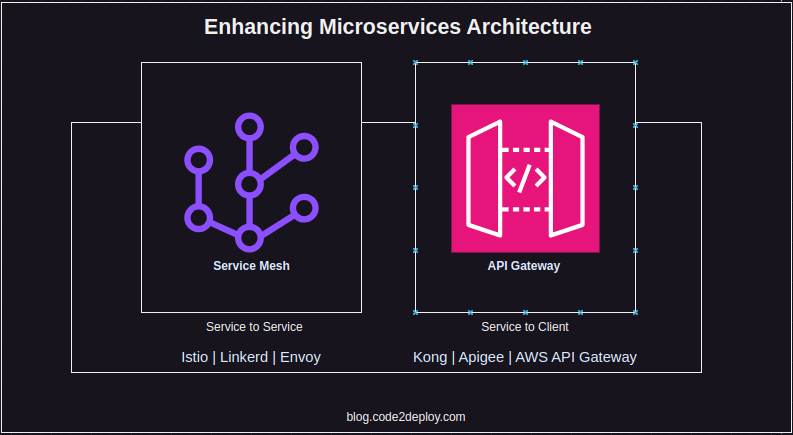In the ever-evolving landscape of microservices architecture, two essential components play a pivotal role in ensuring seamless communication, scalability, and security: Service Mesh and API Gateway. While often used together, they serve distinct yet complementary purposes, enhancing the functionality and reliability of distributed systems. In this blog, we’ll delve into the concepts of Service Mesh and API Gateway, explore their differences, understand their significance, and provide an architectural example with relevant tools and technologies.
Understanding Service Mesh and API Gateway
Service Mesh:
Service Mesh is a dedicated infrastructure layer designed to facilitate communication, monitoring, security, and control between microservices within a distributed application. It acts as a transparent intermediary between services, enabling functionalities such as service discovery, load balancing, circuit breaking, and traffic management. Service Mesh implementations typically utilize sidecar proxies (such as Envoy, Linkerd, or Istio’s Envoy-based proxy) deployed alongside each service instance to handle communication.
API Gateway:
API Gateway serves as a single entry point for clients to interact with the microservices architecture. It provides a unified interface for managing, securing, and routing API requests to the appropriate backend services. API Gateways handle tasks like authentication, authorization, request transformation, rate limiting, and caching, thereby simplifying the client-server interaction and shielding backend services from direct exposure to external clients.
Key Differences:
- Scope: Service Mesh operates at the service-to-service level within the internal network, while API Gateway sits at the edge of the network, serving as the entry point for external clients.
- Functionality: Service Mesh focuses on intra-service communication, observability, and control, whereas API Gateway primarily handles API traffic management, security, and client-facing concerns.
- Granularity: Service Mesh offers fine-grained control over communication between individual services, while API Gateway provides coarse-grained control over APIs exposed to external clients.
Example Scenario: E-commerce Application
Let’s consider an e-commerce application consisting of various microservices like User Service, Product Service, Order Service, and Payment Service. We’ll illustrate how Service Mesh and API Gateway can be utilized in this scenario.
Architecture:
- Service Mesh Implementation: We deploy Istio as our Service Mesh solution. Each microservice instance has an accompanying Istio sidecar proxy.
- API Gateway: For the API Gateway, we use Kong, a popular open-source API Gateway. Kong sits at the edge of the network and handles incoming HTTP requests from clients.
Workflow:
- Client Interaction:
- A client sends an HTTP request to the API Gateway for accessing user-related functionality, like viewing user details or placing an order.
- The API Gateway authenticates and authorizes the request, performs any necessary transformations, and forwards it to the appropriate microservice within the internal network.
- Internal Communication:
- Within the internal network, Istio manages communication between microservices.
- Istio’s sidecar proxies handle service discovery, load balancing, and secure communication between service instances.
- Istio also provides observability features like distributed tracing and metrics collection for monitoring service-to-service communication.
- Service-to-Service Communication:
- For example, when the Order Service needs to communicate with the Payment Service to process an order, Istio ensures secure and reliable communication between these services.
- Istio’s traffic management capabilities enable features like circuit breaking and retry mechanisms to enhance resilience.
Tools and Technologies:
- Service Mesh: Istio, Linkerd, Envoy
- API Gateway: Kong, Apigee, AWS API Gateway
- Observability: Prometheus, Grafana, Jaeger
- Container Orchestration: Kubernetes, Docker Swarm
- Security: JWT (JSON Web Tokens), OAuth 2.0, Mutual TLS (mTLS)
In conclusion, Service Mesh and API Gateway play indispensable roles in modern microservices architecture, addressing distinct aspects of communication and management. By combining these two components effectively, organizations can achieve greater agility, scalability, and security in their distributed systems.
Whether you’re building a new microservices-based application or looking to enhance an existing one, understanding and leveraging the capabilities of Service Mesh and API Gateway can significantly contribute to the success of your architecture.

